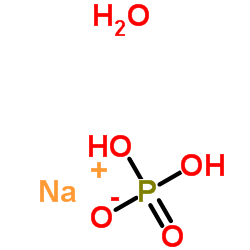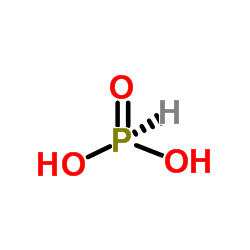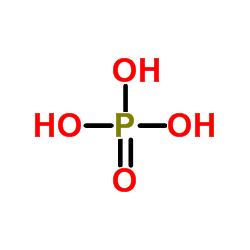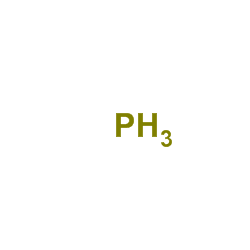Sodium hypophosphite monohydrate

Sodium hypophosphite monohydrate structure
|
Common Name | Sodium hypophosphite monohydrate | ||
|---|---|---|---|---|
| CAS Number | 10039-56-2 | Molecular Weight | 103.97800 | |
| Density | 0.8 g/cm3 (20ºC) | Boiling Point | N/A | |
| Molecular Formula | H2NaO3P | Melting Point | 90°C | |
| MSDS | USA | Flash Point | N/A | |
| Name | Sodium hypophosphite monohydrate |
|---|---|
| Synonym | More Synonyms |
| Density | 0.8 g/cm3 (20ºC) |
|---|---|
| Melting Point | 90°C |
| Molecular Formula | H2NaO3P |
| Molecular Weight | 103.97800 |
| Exact Mass | 103.96400 |
| PSA | 83.50000 |
| LogP | 0.55930 |
| Water Solubility | 1000 g/L (20 ºC) |
Synonym:Phosphinic Acid Sodium Salt Monohydrate; Sodium Hypophosphite Monohydrat Section 2 - COMPOSITION, INFORMATION ON INGREDIENTS
Risk Phrases: None Listed. Section 3 - HAZARDS IDENTIFICATION EMERGENCY OVERVIEW
The toxicological properties of this material have not been fully investigated. Potential Health Effects Eye: May cause eye irritation. Skin: May cause skin irritation. Ingestion: May cause gastrointestinal irritation with nausea, vomiting and diarrhea. The toxicological properties of this substance have not been fully investigated. Inhalation: May cause respiratory tract irritation. The toxicological properties of this substance have not been fully investigated. Chronic: No information found. Section 4 - FIRST AID MEASURES Eyes: Flush eyes with plenty of water for at least 15 minutes, occasionally lifting the upper and lower eyelids. Get medical aid. Skin: Flush skin with plenty of soap and water for at least 15 minutes while removing contaminated clothing and shoes. Get medical aid if irritation develops or persists. Wash clothing before reuse. Ingestion: Do NOT induce vomiting. If victim is conscious and alert, give 2-4 cupfuls of milk or water. Never give anything by mouth to an unconscious person. Get medical aid. Inhalation: Remove from exposure to fresh air immediately. If not breathing, give artificial respiration. If breathing is difficult, give oxygen. Get medical aid. Notes to Physician: Section 5 - FIRE FIGHTING MEASURES General Information: As in any fire, wear a self-contained breathing apparatus in pressure-demand, MSHA/NIOSH (approved or equivalent), and full protective gear. Dusts at sufficient concentrations can form explosive mixtures with air. Combustion generates toxic fumes. Decomposes generating flammable and toxic phosphine gas. Extinguishing Media: Use agent most appropriate to extinguish fire. Use water spray, dry chemical, carbon dioxide, or appropriate foam. Section 6 - ACCIDENTAL RELEASE MEASURES General Information: Use proper personal protective equipment as indicated in Section 8. Spills/Leaks: Clean up spills immediately, observing precautions in the Protective Equipment section. Sweep up or absorb material, then place into a suitable clean, dry, closed container for disposal. Avoid generating dusty conditions. Remove all sources of ignition. Provide ventilation. Section 7 - HANDLING and STORAGE Handling: Wash thoroughly after handling. Remove contaminated clothing and wash before reuse. Use with adequate ventilation. Minimize dust generation and accumulation. Avoid contact with skin and eyes. Avoid ingestion and inhalation. Storage: Store in a cool, dry, well-ventilated area away from incompatible substances. Section 8 - EXPOSURE CONTROLS, PERSONAL PROTECTION Engineering Controls: Use adequate ventilation to keep airborne concentrations low. Personal Protective Equipment Eyes: Wear appropriate protective eyeglasses or chemical safety goggles as described by OSHA's eye and face protection regulations in 29 CFR 1910.133 or European Standard EN166. Skin: Wear appropriate gloves to prevent skin exposure. Clothing: Wear appropriate protective clothing to minimize contact with skin. Respirators: Follow the OSHA respirator regulations found in 29CFR 1910.134 or European Standard EN 149. Always use a NIOSH or European Standard EN 149 approved respirator when necessary. Section 9 - PHYSICAL AND CHEMICAL PROPERTIES Physical State: Solid Appearance: white Odor: odorless pH: Not available. Vapor Pressure: Negligible Viscosity: Not available. Boiling Point: Decomposes Freezing/Melting Point: 90 deg C Autoignition Temperature: Not available. Flash Point: Not available. Explosion Limits, lower: N/A Explosion Limits, upper: N/A Decomposition Temperature: >90 C Solubility in water: Soluble in water Specific Gravity/Density: 0.8 Molecular Formula: NaH2PO2.H20 Molecular Weight: 87.9764 Section 10 - STABILITY AND REACTIVITY Chemical Stability: Stable. However, may decompose if heated. Conditions to Avoid: High temperatures, incompatible materials, dust generation, moisture. Incompatibilities with Other Materials: Strong oxiziders, moisture. Hazardous Decomposition Products: Phosphine, irritating and toxic fumes and gases, toxic fumes of sodium oxide, hydrogen gas. Hazardous Polymerization: Has not been reported. Section 11 - TOXICOLOGICAL INFORMATION RTECS#: CAS# 10039-56-2: SZ5640000 LD50/LC50: CAS# 10039-56-2: Oral, rat: LD50 = 7640 mg/kg. Carcinogenicity: Sodium Hypophosphite Monohydrate - Not listed by ACGIH, IARC, NIOSH, NTP, or OSHA. Other: See actual entry in RTECS for complete information. Section 12 - ECOLOGICAL INFORMATION Other No information available. Section 13 - DISPOSAL CONSIDERATIONS Dispose of in a manner consistent with federal, state, and local regulations. Section 14 - TRANSPORT INFORMATION IATA Shipping Name: Not regulated. Hazard Class: UN Number: Packing Group: IMO Shipping Name: Not regulated. Hazard Class: UN Number: Packing Group: RID/ADR Shipping Name: Not regulated. Dangerous Goods Code: UN Number: Section 15 - REGULATORY INFORMATION European/International Regulations European Labeling in Accordance with EC Directives Hazard Symbols: Not available. Risk Phrases: Safety Phrases: S 24/25 Avoid contact with skin and eyes. WGK (Water Danger/Protection) CAS# 10039-56-2: 2 United Kingdom Occupational Exposure Limits Canada None of the chemicals in this product are listed on the DSL/NDSL list. CAS# 10039-56-2 is not listed on Canada's Ingredient Disclosure List. Exposure Limits US FEDERAL TSCA CAS# 10039-56-2 is not listed on the TSCA inventory. It is for research and development use only. SECTION 16 - ADDITIONAL INFORMATION N/A |
CHEMICAL IDENTIFICATION
HEALTH HAZARD DATAACUTE TOXICITY DATA
|
| Personal Protective Equipment | Eyeshields;Gloves;type N95 (US);type P1 (EN143) respirator filter |
|---|---|
| Safety Phrases | S22-S24/25 |
| RIDADR | NONH for all modes of transport |
| WGK Germany | 3 |
| RTECS | SZ5640000 |
| HS Code | 2835100000 |
|
~% 
Sodium hypophos... CAS#:10039-56-2 |
| Literature: Journal of the American Chemical Society, , vol. 57, p. 300 - 302 P: MVol.B, 3.4.1.5, page 276 - 281 |
|
~% 
Sodium hypophos... CAS#:10039-56-2 |
| Literature: Journal of Inorganic and Nuclear Chemistry, , vol. 15, p. 386 - 387 |

Sodium hypophos... CAS#:10039-56-2 ~% 
Sodium hypophos... CAS#:10039-56-2 |
| Literature: Justus Liebigs Annalen der Chemie, , vol. 550, p. 1 - 31 |
| Precursor 3 | |
|---|---|
| DownStream 10 | |
| HS Code | 2835100000 |
|---|
|
Bismuth nanoparticles integration into heavy metal electrochemical stripping sensor.
Electrophoresis , doi:10.1002/elps.201400609, (2015) Between their many applications bismuth nanoparticles (BiNPs) are showing interest as pre-concentrators in heavy metals detection while being applied as working electrode modifiers used in electrochem... |
|
|
New and clean strategy for the determination of Cu2+ in electroless copper plating baths.
Spectrochim. Acta. A. Mol. Biomol. Spectrosc. 68(1) , 150-5, (2007) This article concerns a new and clean strategy for the determination of Cu(2+) in electroless copper plating baths with differential spectrophotometry. With this strategy, the problem of too high abso... |
|
|
Dissociation of beta 2-microglobulin is responsible for selective reduction of HLA class I antigenicity following acid treatment of cells.
Mol. Immunol. 30(14) , 1223-30, (1993) Beta 2-Microglobulin (beta 2 m) dissociated from surface HLA class I complex following exposure of cells to low pH and was detected in supernatant by radioimmunoprecipitation with specific monoclonal ... |
| Sodiumhypophosphitemonohydrate |
| EINECS 231-669-9 |
| Fosfornan sodny [Czech] |
| MFCD00149207 |
| Sodium Hypophosphite Monohydrate |



 CAS#:13598-36-2
CAS#:13598-36-2 CAS#:7664-38-2
CAS#:7664-38-2 CAS#:7803-51-2
CAS#:7803-51-2 CAS#:6303-21-5
CAS#:6303-21-5 CAS#:14000-31-8
CAS#:14000-31-8 CAS#:124-43-6
CAS#:124-43-6 CAS#:56-81-5
CAS#:56-81-5 CAS#:7647-14-5
CAS#:7647-14-5
